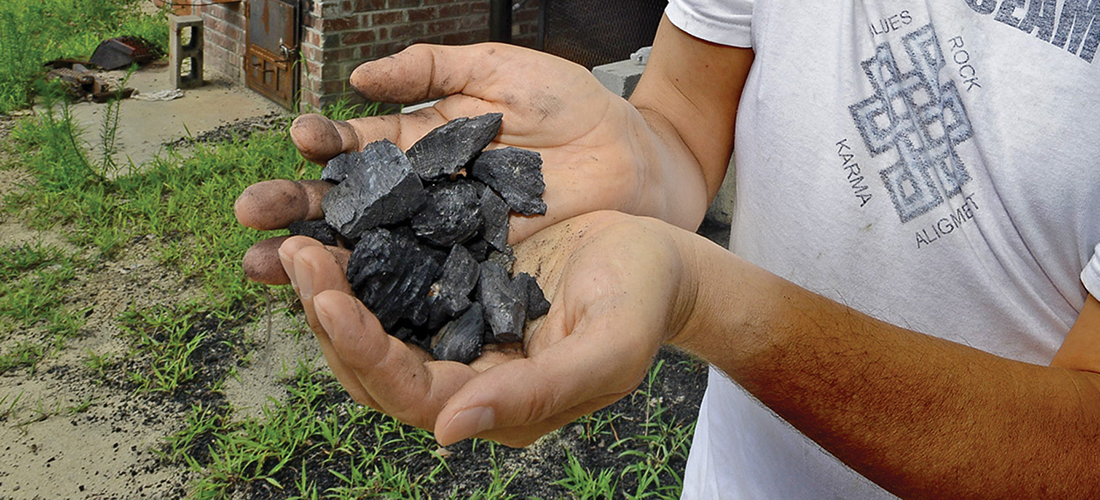
Secrets of pre-Columbian soils might hold a key to better harvests
By Jan Leitschuh
Spring beckons. Garden digging commences. Some will work organic matter and cover crops into their soil; a few innovative others will also use powdered biochar, an intriguing “new” substance with history dating back thousands of years — and a whole lot of worldwide interest and research.
To some, that soulful, springtime urge to root about in rich dirt is an exquisite, primal thing. We in the Sandhills can do it too. Lucky us. In March, others with sticky, clay-based soils have to wait. Our native sandy soil has many blessings — easy to work, drains well with a structure that’s hard to destroy, and our dirt doesn’t stain everything orange like clay.
But, and it’s a big but, our sandy soils have significant drawbacks. They don’t hang on to nutrients or water very well. They . . . drain. Fertilize your vegetable garden and — whoosh! — one of our typical growing-season deluges will rinse those expensive nutrients right out of the root zone and down into the water table. Farmers find they have to re-fertilize frequently, and irrigate often during dry spells, driving up costs. Our soils are also acidic, in part due to this “rinsing” action of frequent and hard rains. The Sandhills were among the last areas of the state to be settled, due to poor soils.
Organic matter will help all these issues.
And so will biochar, say local growers Mark Epstein and Billy Bullen of Flow Farms of Aberdeen. They make their own biochar and amend their very sandy soils with this special charcoal-like substance. Extremely porous, biochar shares many beneficial properties with organic matter — and best of all, it’s very stable and lasts far longer than compost. In fact, thousands of years longer. Studies have reported positive effects from biochar on crop production in “degraded and nutrient-poor soils,” that is, sand.
Could biochar become an essential tool in our Sandhills gardening — and even agricultural — tool kit?
“It’s an exciting approach,” says Taylor Williams of Moore County Cooperative Extension. “There is some new research on it about to commence right here in Jackson Springs, at the Sandhills Research Station.” Mike Parker, a NCSU tree fruit specialist, was recently was awarded a $63,000 Specialty Crop grant to study the effect of soil biochar incorporation on peach production at the Sandhills Research Station.
Take organic matter (OM) first. Work in some old compost, rotted manure or leaves, being exquisitely careful of the source. We don’t want any residual herbicides, heavy metals, weed seeds or pesticides. Voilà, you just increased your soil’s water — and nutrient — holding capacity. This is worth restating. In droughty, sandy soils, this ability to capture water and fertility is critical to making a crop. OM also feeds the soil life and microorganisms, which help make nutrients available to plants. Fabulous stuff all around, except for one sent. little problem. Assuming you can find a clean and affordable source, OM burns up fast during our hot, humid Southern summers, often before a crop is finished fruiting.
This is where biochar seems to offer benefits. Biochar is not just charcoal like your BBQ grill briquettes. Biochar refers to a specific sub-type of charcoal made under particular temperature and low oxygen conditions, called pyrolysis. It becomes “thermally modified biomass.” Biochar is what is left after the volatile material in wood is cooked off without much oxygen. The end result is impervious to microbial breakdown, even as it provides soil microbes with open-armed living conditions, a kind of “Hotel California” for soil life. It is more effective than OM at improving soil fertility over the longterm. Some reports have biochar increasing crop yields by significant percentages, especially as a field mellows.
Epstein and Bullen make their own biochar, torching waste from their woods in a specially built burner called an Adam retort. “Everything for us is so far experimental,” explains Epstein. “Last year, we did 15 to 20 burns. Every time we do it, we learn more.” Epstein is a veritable connoisseur of soil. As a longtime vegan, as well as a produce grower, he eats what he grows. That led him naturally to research the most nutritious soils to cultivate in the Sandhills.
The biochar story is a marvelous one, stretching back thousands of years, deep into the South American Amazon rain forest. Early Spanish conquistadors exploring the Amazon reported large, shining cities, with vast and productive fields, El Dorado. But later explorers found only jungles and poor yellow soil, and only small villages with subsistence plots. Rain forests share some of our local issues — frequent hard rains wash nutrients from the soils, and create poor fertility and acidity. It didn’t look as if there was enough fertile soil to support a large “shining city,” much less a culture of them.
We now know that wasn’t so.
Archeologists discovered and mapped certain black, fertile patches of soil they labeled “terra preta,” a Portuguese term meaning black earth. These surprisingly fecund areas were created by the pre-Columbian Amazon Indian culture through certain slash-and-char, low-oxygen techniques — charring (as opposed to combusting), then mixing the black, pounded result with the poor local soils. This prehistoric, man-made soil was found to be higher in nitrogen, phosphorus, potassium and calcium than adjacent soils. It held water and reduced leaching of nutrients. Scientists have referred to it a “microbial reef” that promotes mycorrhizae growth and other beneficial microbes. The Amazonian terra preta, all together about the size of Great Britain, could support large-scale agriculture. They had turned some of the world’s worst soils into some of the best.
And, most intriguingly, it has retained its fertility for thousands of years. These terra preta soils are understandably popular with the local farmers producing cash crops such as papaya and mango, which are said to grow about three times as rapidly as on surrounding infertile soils. (For archeology buffs who wish to look deeper into this fascinating story, Google a program on YouTube called “The Secrets of El Dorado”).
Modern writers have called it “the magic soil.” Could it help the Sandhills too?
“I think it’s an important piece of the puzzle,” says Epstein.
Scientists speculate that two of the greatest problems facing the world — climate change and the hunger crisis — might be alleviated, in part, by biochar.
Biochar increases crop yield several ways. The production process leaves a stable product with a massive amount of micropores, like an organic sponge that won’t biodegrade. While not fertile in itself, biochar’s tiny openings help grab nutrients that might otherwise rinse away to downstream pollution, and bank them for future use, keeping the goodies in the root zone where plants can pull from them as needed. Biochar increases water-holding capacity, maintaining soil moisture over a wide variety of climate conditions, and doesn’t burn off like organic matter. Remember those fertile Amazonian patches, over 1,000 years old? The Pre-Columbian material is still there, acting as a water and nutrient bank, still fertile.
Epstein agrees on both counts. “We’ve noticed our soil holds water better now,” he says. “We have ‘sugar sand’ here on our property, with very little natural organic matter. It’s classic Sandhills sand.” Since adding ground biochar to his soil, he’s noticed that, “we don’t have to irrigate as much. Go into the middle of our fields — it’s very high in organic matter. We still use cover crops of legumes and grasses that are an important factor in tilth. Yet, at the end of the season, we still have good soil.”
Biochar also adds carbon to the soil. Normally, cropping the same piece of ground year after year leads to a reduction in soil carbon. Carbon makes up about 50 percent of a plant’s material, so when a crop is harvested, the carbon leaves with it. This can be mitigated with “green manures” and cover crops that are tilled in spring, but again, OM burns off. Loss of soil carbon decreases productivity.
Not the soil on Flow Farms. Anecdotally, crops are good. Scientifically, soil tests show increasing CEC, or cation exchange capacity — a measure of a soil’s ability to grab nutrients. Soil tests also indicate ample fertility remaining in the soil. “With an immense surface area, biochar holds on to enormous amounts of ions,” says Epstein. “It’s a magnet to nutrients, grabs them up like a sponge. We’re not losing our soluble materials year after year.”
Biochar as stable, fixed carbon can store large amounts of greenhouse gases in the ground for centuries, potentially reducing or stalling the growth in atmospheric greenhouse gas levels, say some scientists. From 2005 to 2012, there were 1,038 articles referencing the word “biochar” or “bio-char” in the topic indexed in the ISI Web of Science. Institutions as diverse as Cornell University, the Agricultural Research Center of Israel and the University of Edinburgh have dedicated research units.
Flow Farms has finally produced enough of its product for its own fields, and will offer biochar to the public for the first time this year, price still unknown. “We’re trying to make it affordable to people and still make an honest return,” says Epstein. Because of the soluble nutrient capture, “It’s an upfront cost that lessens over the years,” he says.
The economics have yet to be determined. According to one source, application rates of one to eight tons per acre may be required for significant improvements in plant yields. Biochar costs in developed countries vary widely. With few producers, prices are often too high for the farmer/horticulturalist. An alternative is to use small amounts of biochar in lower cost biochar-fertilizer complexes.
Biochar is not fertile in itself, but collects nutrients from its environment, leading some users to pre-soak their biochar in fertilizers or compost. Epstein prefers to mix his into the top few inches of soil, “and let it age in its natural environment.”
As an organic, or as Epstein puts it, “veganic” grower, he also adds many beneficial natural elements, such as chopped leaves, gypsum, azomite, kelp meal, green sand, Tennessee Brown phosphate and lime. “We’ve done everything but come in and kiss the soil,” he jokes. But then, turning sand into black gold is his hobby and passion.
In springtime, any gardener understands this at gut level. Stay tuned to biochar. The char of the past may become a tool of the future here. PS
Jan Leitschuh is a local gardener, avid eater of fresh produce and co-founder of the Sandhills Farm to Table Cooperative.





